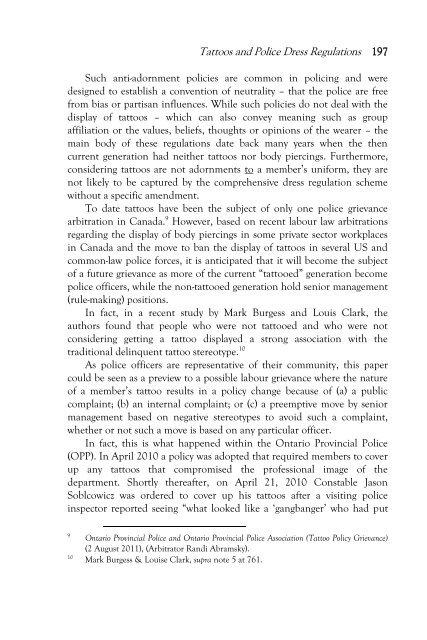Tattoos and Police Dress Regulations - Robson Hall Faculty of Law
Tattoos and Police Dress Regulations - Robson Hall Faculty of Law
Tattoos and Police Dress Regulations - Robson Hall Faculty of Law
Create successful ePaper yourself
Turn your PDF publications into a flip-book with our unique Google optimized e-Paper software.
<strong>Tattoos</strong> <strong>and</strong> <strong>Police</strong> <strong>Dress</strong> <strong>Regulations</strong> 197<br />
Such anti-adornment policies are common in policing <strong>and</strong> were<br />
designed to establish a convention <strong>of</strong> neutrality – that the police are free<br />
from bias or partisan influences. While such policies do not deal with the<br />
display <strong>of</strong> tattoos – which can also convey meaning such as group<br />
affiliation or the values, beliefs, thoughts or opinions <strong>of</strong> the wearer – the<br />
main body <strong>of</strong> these regulations date back many years when the then<br />
current generation had neither tattoos nor body piercings. Furthermore,<br />
considering tattoos are not adornments to a member’s uniform, they are<br />
not likely to be captured by the comprehensive dress regulation scheme<br />
without a specific amendment.<br />
To date tattoos have been the subject <strong>of</strong> only one police grievance<br />
arbitration in Canada. 9 However, based on recent labour law arbitrations<br />
regarding the display <strong>of</strong> body piercings in some private sector workplaces<br />
in Canada <strong>and</strong> the move to ban the display <strong>of</strong> tattoos in several US <strong>and</strong><br />
common-law police forces, it is anticipated that it will become the subject<br />
<strong>of</strong> a future grievance as more <strong>of</strong> the current “tattooed” generation become<br />
police <strong>of</strong>ficers, while the non-tattooed generation hold senior management<br />
(rule-making) positions.<br />
In fact, in a recent study by Mark Burgess <strong>and</strong> Louis Clark, the<br />
authors found that people who were not tattooed <strong>and</strong> who were not<br />
considering getting a tattoo displayed a strong association with the<br />
traditional delinquent tattoo stereotype. 10<br />
As police <strong>of</strong>ficers are representative <strong>of</strong> their community, this paper<br />
could be seen as a preview to a possible labour grievance where the nature<br />
<strong>of</strong> a member’s tattoo results in a policy change because <strong>of</strong> (a) a public<br />
complaint; (b) an internal complaint; or (c) a preemptive move by senior<br />
management based on negative stereotypes to avoid such a complaint,<br />
whether or not such a move is based on any particular <strong>of</strong>ficer.<br />
In fact, this is what happened within the Ontario Provincial <strong>Police</strong><br />
(OPP). In April 2010 a policy was adopted that required members to cover<br />
up any tattoos that compromised the pr<strong>of</strong>essional image <strong>of</strong> the<br />
department. Shortly thereafter, on April 21, 2010 Constable Jason<br />
Soblcowicz was ordered to cover up his tattoos after a visiting police<br />
inspector reported seeing “what looked like a ‘gangbanger’ who had put<br />
9<br />
Ontario Provincial <strong>Police</strong> <strong>and</strong> Ontario Provincial <strong>Police</strong> Association (Tattoo Policy Grievance)<br />
(2 August 2011), (Arbitrator R<strong>and</strong>i Abramsky).<br />
10<br />
Mark Burgess & Louise Clark, supra note 5 at 761.














